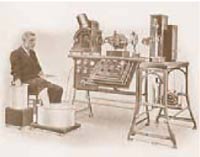"He is the best physician who is the most ingenious inspirer of hope."
Samuel Taylor Coleridge, English Poet and Philosopher, 1772-1834
 |
|
Willem Einthoven,MD,PhD,
Dutch physiologist |
In 1903, Dutch physiologist Willem Einthoven, MD, PhD invented the electrocardiograph, a machine that measures the minute electrical currents generated by the heart. Initially, it was a cumbersome and costly device, taking five technicians to operate. During the procedure, patients had to place both hands and both feet in buckets of water.But as a result of this advance cardiologists began, for the first time, to fully understand the electrical processes involved in generating the heart beat.With this knowledge, they were able to more precisely diagnosis certain cardiovascular problems.
A little more than a century later, scientific ingenuity has led to the development of many other advances. Scientists, for instance, have developed magnetic resonance imaging and other noninvasive ways to study the aging heart. Researchers have discovered a host of innovative drug treatments to help the ailing heart and arteries work better. And cardiologists and surgeons have successfully pioneered the use of cardiac catheterization, cardiovascular stents, implantable pacemakers, bypass surgery, and heart transplants.
No doubt about it, doctors know more about the heart and how to keep it healthy than at any other time in history. In just the past 30 years, gerontologists have revolutionized ideas about what happens in the older heart. They’ve learned, for instance, that age-related changes in the structure and function of the heart occur in virtually every person.Mounting evidence suggests that some of these changes, previously thought to be a part of normal aging, precede and predict the onset of cardiovascular diseases, even among those who do not yet have signs or symptoms of disease. But they’ve also learned that preventive measures, such as getting regular exercise, eating a healthy diet, and not using tobacco, can have a profound impact on the aging cardiovascular system.
In the future, interventions to slow accelerated aging of the heart and arteries in apparently healthy young and middle-age people could prevent or delay the onset of heart disease, stroke, and other cardiovascular disorders in later life, Dr. Lakatta says. These interventions may take many forms. For instance, the more we understand about the changes that take place in cells and molecules during aging, the closer we get to the possibility of designing drugs targeted to those changes. Gene therapies can also target specific cellular changes and could potentially be a way to intervene in the aging process.
Achieving these goals will likely require considerable effort and as much, or perhaps even more, ingenuity and innovation in the coming years as has been shown in the past. NIA investigators and others are already taking steps to meet these challenges. They still have many questions to answer and mysteries to solve. But as this work progresses and scientists unravel more of the aging heart’s secrets, the hope of forestalling cardiovascular disease and improving the quality of life for older people may come closer to reality.
<< Back | Next >>
